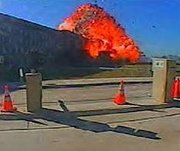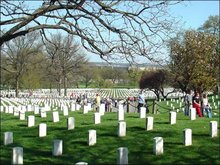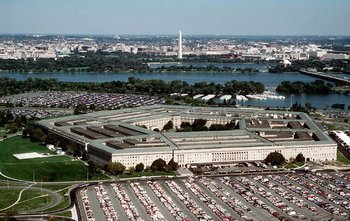Arlington County, Virginia
|
|
Arlington County is a county located in the U.S. commonwealth of Virginia, directly across the Potomac River from Washington, DC. Originally part of the District of Columbia, by an act of Congress July 9, 1846, the area south of the Potomac was returned (retroceded) to Virginia effective in 1847.
As of 2000, the population is 189,453. Its county seat is the census-designated place of ArlingtonTemplate:GR. Strictly speaking, it is inaccurate to refer to a city or town of Arlington. All cities within the state are independent of counties, though normally towns may be incorporated within counties. However, Arlington has no existing incorporated towns, and Virginia law prevents the creation of any new municipality within a county that has a population density greater than 1,000 persons per square mile, which Arlington County (and its neighbor, Fairfax County) exceeds.
Arlington is a partner city with Aachen in Germany, Reims in France, and Coyoacán in Mexico.
| Contents |
|
1.1 Alexandria County |
History
Alexandria County
Us-va-ar.gif
Arlington County shares with a portion of the independent City of Alexandria, Virginia the distinction of being once in Virginia, then ceded to the US government to form the District of Columbia, and later retroceded to Virginia.
Arlington County was part of the original 10-mile square created as the District of Columbia in 1791 pursuant to Article I, Section 17, of the United States Constitution. The portion of the District created from territory ceded by Virginia was termed Alexandria County of the District of Columbia. It included the present Arlington County plus part of what is now the independent city of Alexandria, Virginia. The area was retroceded to Virginia by an act of the United States Congress on July 9, 1846 following a referendum of its citizens.
In 1870, Alexandria seceded from Alexandria County, and because of the confusion between the city and the county having the same name, a movement started to rename Alexandria County. In 1920, the name Arlington County was adopted, after Arlington House, the home of the American Civil War general Robert E. Lee, which stands on the grounds of what is now Arlington National Cemetery.
Arlington National Cemetery
Arlington National Cemetery, in Arlington, Virginia is an American military cemetery established during the American Civil War on the grounds of Robert E. Lee's home, Arlington House. It is situated directly across the Potomac River from Washington, D.C., next to the present day location of The Pentagon. With more than 260,000 people buried there, Arlington National Cemetery has the second-largest number of people buried of any national cemetery in the United States.
Arlington House was named after the Custis family's homestead on Virginia's Eastern Shore. It is uniquely associated with the families of Washington, Custis, and Lee. Begun in 1802 and completed in 1817, it was built by George Washington Parke Custis. After his father died, young Custis was raised by his grandmother and her second husband, the first US President George Washington at Mount Vernon. Custis, a farsighted agricultural pioneer, painter, playwright, and orator, was interested in perpetuating the memory and principles of George Washington. His house became a "treasury" of Washington heirlooms.
In 1804 Custis had married Mary Lee Fitzhugh. Their only child to survive infancy was Mary Anna Randolph Custis, born in 1808. Young Robert E. Lee, whose mother was a cousin of Mrs. Custis, frequently visited Arlington. Two years after graduating from West Point, Lieutenant Lee married Mary Custis at Arlington on June 30, 1831. For 30 years, Arlington House was home to the Lees. They spent much of their married life traveling between U.S. Army duty stations and Arlington, where six of their seven children were born. They shared this home with Mary's parents, the Custis family.
When George Washington Parke Custis died in 1857, he left the Arlington estate to Mrs. Lee for her lifetime and afterwards to the Lees' eldest son, George Washington Custis Lee.
The Lee-Custis estate house (http://www.nps.gov/arho/) and 200 acres (800,000 m²) of ground immediately surrounding it) was confiscated from Robert E. Lee during the Civil War, and was designated officially as a military cemetery June 15, 1864, by Secretary of War Edwin M. Stanton. In 1882, after many years in the lower courts, the matter of the ownership of Arlington National Cemetery was brought before the United States Supreme Court. The Court decided that the property rightfully belonged to the Lee Family. The United States Congress then appropriated the sum of $150,000 for the purchase of the property from the Lee Family.
Veterans from all the nation's wars are buried in the cemetery, from the American Revolution through the military actions in Afghanistan and Iraq. Pre-Civil War dead were re-interred after 1900.
The Tomb of the Unknowns, also known as the Tomb of the Unknown Soldier, stands atop a hill overlooking Washington, DC. Other frequently visited sites in the cemetery are the USMC War Memorial, commonly known as the "Iwo Jima Memorial"; the Netherlands Carillon; and the grave of President John F. Kennedy. Kennedy is buried with his wife and some of their children. His grave is marked with an "Eternal Flame." His brother Senator Robert F. Kennedy is also buried nearby. Another President, William Howard Taft, who was also a Chief Justice of the U.S. Supreme Court, is the only other President buried at Arlington.
The Pentagon
The Pentagon in Arlington County is the headquarters of the United States Department of Defense. It was dedicated on January 15, 1943 and it is the world's largest office building. Although physically located in Arlington County, the Pentagon uses a Washington, D.C. address.
The building is pentagon-shaped in plan and houses approximately 23,000 military and civilian employees and about 3,000 non-defense support personnel. It has five floors and each floor has five ring corridors.
Built during the early years of World War II, it is still thought of as one of the most efficient office buildings in the world. Despite 17.5 miles (28 km) of corridors it takes a maximum of seven minutes to walk between any two points in the building.
It was built from 680,000 tons of sand and gravel dredged from the nearby Potomac River that were processed into 435,000 cubic yards (330,000 m³) of concrete and molded into the pentagon shape. Very little steel was used in its design due to the needs of the war effort.
The central plaza in the Pentagon is the largest "no-salute, no-cover" area (where hats need not be worn and salutes are not required) in the world. The open space in the center is informally known as ground zero, a nickname originating during the Cold War when it was thought of as the most likely target of a nuclear missile.
During World War II, the earliest portion of the Henry G. Shirley Memorial Highway was built in Arlington in conjunction with the parking and traffic plan for the Pentagon. This early freeway, opened in 1943, and completed to Woodbridge, Virginia in 1952, is now part of Interstate 395.
9/11 Attack hits Arlington County

Sixty years to the day after groundbreaking on the Pentagon, the September 11, 2001 attacks occurred. The Pentagon was one of the three major US buildings struck by airliners hijacked by terrorists affiliated with al-Qaeda, a militant terrorist organization.
American Airlines Flight 77 crashed into the western side of the Pentagon at 9:37 AM EDT, killing all of its 58 passengers (including the hijackers) and 6 crew. The section of the Pentagon hit consisted mainly of new, unoccupied offices and was damaged by the crash and the ensuing violent fire. The crash and subsequent fire penetrated three outer ring sections of the western side. The outermost ring section was largely destroyed, and a large section collapsed. 125 people in the Pentagon died from the attack. For pictures and graphics showing the damage in the impact see this briefing (http://www.defenselink.mil/news/Sep2001/g010915-D-6570C.html).
It has been speculated that the hijackers of a fourth hijacked aircraft, United Airlines Flight 93, intended to crash into either the U.S. Capitol or the White House in Washington, DC. Black box recordings revealed that the passengers attempted to seize control of the plane from the hijackers and when rocking the plane failed to subdue the passengers, the hijackers crashed the aircraft in a field near Shanksville and Stonycreek Township in Somerset County, Pennsylvania.
During the September 11, 2001 attacks, the heroic efforts of Arlington County Fire Department and EMS personnel (and others from neighboring jurisdictions), as well of those aboard United Airlines Flight 93 helped limit the loss of life and damages to the Washington DC area.
Transportation
Airports
Arlington County is the home of Ronald Reagan Washington National Airport.
Metro
Arlington County is served by the Orange, Blue, and Yellow Lines of the Washington Metro, the Virginia Railway Express, Metrobus, and a local public bus system Arlington Transit (http://www.commuterpage.com/art/) (ART).
Roads in Arlington
Length of roads in county
According to a rough estimation provided to one of the editors of this article in a 2005 E-mail by an engineering office of Arlington County, there are approximately 559 miles of roads in the county.
Maintenance of roads
Rosslyn_(Arlington),_Virginia_sunset.JPG
Arlington County is one of only two counties in Virginia which maintain their own roads (with the exception of primary state highways, including U.S. Highways and Interstates), the other being Henrico County outside the State Capital of Richmond. This special status was due to the existence of county highway departments prior to the creation of the state agency which is now VDOT in 1927, and the assumption of local roads by that agency in 1932. The control of the roads system is considered a powerful advantage for community urban planners, who can require developers to contribute to funding needed for road needs serving their projects.
Addressing and street-naming conventions
Arlington is divided into two sections by the east-west US 50 (Arlington Boulevard), which divides streets into "north" and "south" designations. East-west streets are numbered, radiating outwards from Route 50; most numbers have one "street" and one "road" on each side of Route 50. North-south streets are alphabetical from east to west, with streets beginning with the letters A through W (as X, Y, and Z are skipped). When the end of the alphabet is reached it starts over from the beginning, but each street name will now have one more syllable than in the previous set. Ball Street (one syllable 'B') is the easternmost street and Arizona Street is the westernmost (four syllable 'A').
The numbered and alphabetical streets described in the preceding paragraph are designated as though Arlington County were laid out on a consistent grid plan, which for the most part it is not. Originally, the various communities in the county had independent street-naming conventions. However, when county officials asked the United States Postal Service to place the entire county in a single "Arlington, Virginia" postal area, the USPS refused to do so until the county had a unified addressing system. For that reason, and also because Arlington is hilly, it is common for streets to terminate and continue later on in another location.
Arterial routes
This does not apply to the main arteries (none of which are "streets"). The north-south arteries from east to west are US 1 (Jefferson Davis Highway), Walter Reed Drive, Glebe Road, George Mason Drive and Carlin Springs Road. The east-west arteries from north to south are Williamsburg Boulevard, Yorktown Boulevard, Lee Highway (US 29), Wilson Boulevard, US 50 (Arlington Boulevard), Columbia Pike and Four Mile Run Drive.
Another main artery, Washington Boulevard, used to be a cow path, and runs both east-west and north-south. It runs east-west through most of the county between Wilson Boulevard and Lee Highway. When it gets to the east side of town, it turns south and crosses US-50 and becomes VA 27, a freeway, before crossing Columbia Pike and intersecting with I-395. It then turns back northeast and runs past the Pentagon to end at the George Washington Memorial Parkway.
Geography
Arlington is one of the smallest counties in the United States. According to the U.S. Census Bureau, the county has a total area of 67 km² (26 mi²), of which about 12 km² (4.6 mi²) is federal property.
Arlington is located at 38°52'49" North, 77°6'30" West (38.880344, -77.108260)Template:GR. It is bounded on the north by Fairfax County, on the west by the City of Falls Church, on the south by the City of Alexandria, and on the east by the Potomac River; across the river is the City of Washington, DC.
Neighborhoods in Arlington Country
Arlington_VA_200x440.jpg
Image:Arlington_VA_200x440.jpg
Missing image
DC_&_Arlington_VA.png
Image:DC & Arlington VA.png
</div>
There are numerous unincorporated neighborhoods within Arlington County that are commonly referred to by name as if they were distinct towns, and characterized by the county as "urban villages." These include:
- Alcova Heights
- Arlington Forest
- Arlington Heights
- Arlington Ridge
- Arlington View
- Arno
- Ashton Heights
- Aurora Hills
- Barcroft
- Bluemont
- Buckingham Villiage
- Cherrydale
- Claremont
- Columbia Forest
- Columbia Heights
- Dominion Hills
- Donaldson Run
- East Falls Church
- Fairlington
- Forest Hills
- Glencarlyn
- Long Branch
- Lyon Park
- Lyon Village
- Madison Manor
- Maywood
- Nauck (also known as Green Valley)
- Waverly Hills
- Woodlawn
- Westover
- Williamsburg
- Yorktown
Demographics
As of the censusTemplate:GR of 2000, there are 189,453 people, 86,352 households, and 39,290 families residing in the county. The population density is 2,828/km² (7,323/mi²). There are 90,426 housing units at an average density of 1,350/km² (3,495/mi²).
The racial makeup of the county is:
28% of Arlington residents are foreign-born.
There are 86,352 households out of which 19.30% have children under the age of 18 living with them, 35.30% are married couples living together, 7.00% have a female householder with no husband present, and 54.50% are non-families. 40.80% of all households are made up of individuals and 7.30% have someone living alone who is 65 years of age or older. The average household size is 2.15 and the average family size is 2.96.
In the county, the population is spread out with 16.50% under the age of 18, 10.40% from 18 to 24, 42.40% from 25 to 44, 21.30% from 45 to 64, and 9.40% who are 65 years of age or older. The median age is 34 years. For every 100 females there are 101.50 males. For every 100 females age 18 and over, there are 100.70 males.
The median income for a household in the county is $63,001, and the median income for a family is $78,877. Males have a median income of $51,011 versus $41,552 for females. The per capita income for the county is $37,706. 7.80% of the population and 5.00% of families are below the poverty line. Out of the total population, 9.10% of those under the age of 18 and 7.00% of those 65 and older are living below the poverty line. In 2004 the average single-family home sales price passed $600,000, approximately triple the price less than a decade before, and the median topped $550,000.
Arlington spends about half of its revenue on education, making it one of the top ten per-pupil spenders in the nation (as of 2004, over $13,000), and maintains one of the best educational programs in the region.
External links
- Arlington County official website (http://www.arlingtonva.us/)
- Arlington Historical Society (http://www.arlingtonhistoricalsociety.org/)
- Northern Virginia Assn. of Realtors (market statistics) (http://www.nvar.com/)
- Max X. Miller Online September 11, 2001 Audio and Video Archive and Memorial including Washington DC & Arlington, VA Fire Depts. (http://mxmonline.tripod.com/)
- The Final 9/11 Commission Report (http://www.gpoaccess.gov/911/index.html)
- AA Flight 77: Minute by Minute (http://www.cooperativeresearch.org/timeline.jsp?timeline=complete_911_timeline&day_of_911=aa77)
- http://www.arlingtoncemetery.org/
- http://www.nps.gov/arho/
- Glencarlyn neighborhood webpage (http://www.glencarlyn.org/)
- http://www.interment.net/data/us/va/arlington/arlington/index.htm


